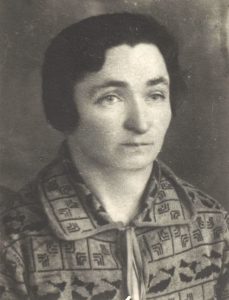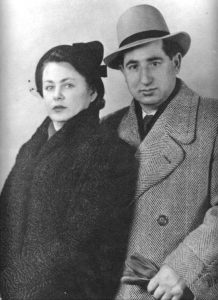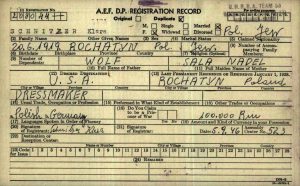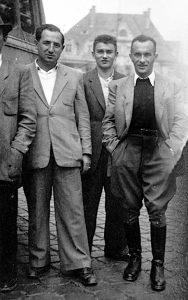![]() Ця сторінка також доступна українською.
Ця сторінка також доступна українською.
Oral interview #5039 with Klara Schnytzer by Ursula Flicker OAM, 14 January 1980, for the B’nai Brith 1980 Holocaust Exhibition, copyright Melbourne Holocaust Museum (MHM, formerly the Jewish Holocaust Centre), Melbourne, Australia. Reproduction by permission only. See also the lightly-edited transcript.
Click the right arrow below to start the playback:
Introduction
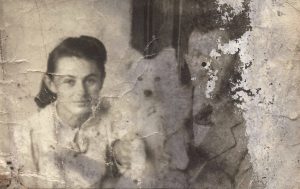
Fragments of prewar life in Rohatyn: Klara with Meyer Weisbraun and a dog. Source: Schnytzer-Wald Family Collection.
Presented here is an audio recording of Klara Schnytzer (née Wald), a Jewish Holocaust survivor from Rohatyn, from an interview by Ursula Flicker OAM for the Survivor Testimonies collection of the Melbourne Holocaust Museum (MHM). The interview took place in Melbourne, Australia, on 14 January 1980, when Klara was 60 years old; she was 22 years old when the Germans occupied Rohatyn and all of what was then eastern Poland, today western Ukraine. The interview was in English, with a recorded duration of 38 minutes.
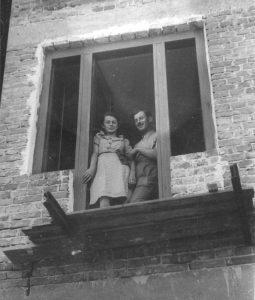
Klara and Meyer together before the German occupation, perhaps at their residence on the Rohatyn rynek.
Source: Schnytzer-Wald Family Collection.
Also presented here is a lightly-edited transcript of the interview, to aid interpretation and further use of the testimony. Like Klara, Ursula Flicker was also a Holocaust survivor from Poland, and a founding archivist for the MHM. As one can hear in the recording, both the interviewer and the interviewee spoke with accented English, and as in any conversation they sometimes spoke over each other as the questions and replies proceeded; the transcript edits are intended to clarify and focus the audio with a minimum of intrusions. An unedited version of the transcript is also linked to the edited version, but ultimately the best source is the original audio itself, linked above.
Survivors of the Rohatyn Jewish ghetto were rare, fewer than five percent of the large prewar Rohatyn Jewish community, and many of the survivors did not know each other well before or during the German occupation. However, as will be seen below Klara Wald was well-known and esteemed, both for her own qualities and for those of her family, and she appears in the published memoirs of two other survivors as a prominent figure in unusual shared experiences of the occupation period.
As with any oral history there are one or two factual errors in Klara’s interview responses, but those do not diminish the power of her testimony. Some details she omitted of episodes of her life which we now consider significant, after comparison to other memoirs and histories more than 40 years after the interview, have been filled in below from those other sources. There are hints in Klara’s words about survivor stories for which we regrettably have no original documentation or testimony, such as the terrible experience in Rohatyn on 20 March 1942 of the man Klara later married after the Soviet army drove the German forces out of eastern Poland. Those shadows make Klara’s clear and frank words all the more precious for us.
A Brief Summary of Klara’s Life
Note: Klara’s life began in multicultural eastern Poland which had Austrian, Polish, and Ukrainian language history as well as mixed Jewish culture; see the history pages on this website for more information. As a result, most Jews who lived there at the time were known by several name spelling variants as well as nicknames and formal names in administrative records. Many survivors of the Holocaust in the area gained new names and name spellings when they emigrated to new countries with new languages. To avoid distraction in the history below, we use only a single spelling for each name, and in this paragraph only we list some of the more common variants for Klara, her family, and others: Klara (Clara) Wald; Wolf (Velvel, Wilhelm) Wald; Sara (Sala, Shela) Wald; Hela (Helen) Wald; Anna (Andzia) Wald; Meyer (Mayer, Meir) Weisbraun (Weissbraun, Weisbroin, Weisbrojn); Rozka (Roza, Rozia, Rosette) Faust (later Halpern); Paul (Pinkas, Paweł) Trepman; Anna Bachynska (Baczynska); Tanya (Tunia, Marta) Bachynska; Israel (Izrael) Schnytzer (Schnitzer).
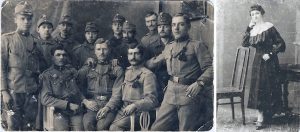
Klara’s father Wolf (third from left at back) with fellow soldiers in the Austrian army; at right, Klara’s mother Sara. Source: Schnytzer-Wald Family Collection.
Klara Wald was born in July 1919 in the village of Podgrodzie (today Pidhoroddia) in the chalk hills about 4km north of the Rohatyn town center (“podrodzie” translates roughly as “foothills”). Her parents were Sara (née Nadel) and Wolf Wald; her father had recently served in the Austrian imperial army in World War I. Sara was born in the city of Stanislau (Stanisławów, today Ivano-Frankivsk) but Wolf was born in the adjacent village of Zalipie (today Zalypia) on the Hnyla Lypa River, where his parents and older brother Majer (later a tobacco and firewood merchant in Podgrodzie) were also born, as well as many other extended family members going back generations; Klara had cousins and other relatives in the area around Rohatyn. A 1903 Austrian business directory lists Klara’s grandfather Moses Wald as an egg and grain trader in Podgrodzie.
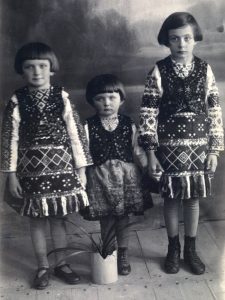
The Wald girls in Ukrainian folk dresses: Hela, Anna, and Klara. Source: Schnytzer-Wald Family Collection.
Klara was the eldest of three sisters; she was followed a few years later by Hela and then Anna. As was typical of the villages in the Rohatyn region, neither Podgrodzie or Zalipie had much Jewish presence: in the 1921 Polish census, Podgrodzie counted only 42 Jews among 885 residents, and Zalipie only 7 out of 374, while Rohatyn counted 2233 Jews out of 5736 residents. We don’t know a lot about Klara’s early life, but years later she told her grandchildren that she had to walk from Podgrodzie to school in Rohatyn, an experience she didn’t enjoy.
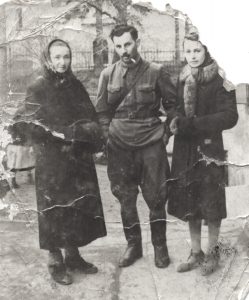
Meyer Weisbraun with his wife Klara and her mother Sara in 1939. Source: Schnytzer-Wald Family Collection.
At some point before the war, Klara moved to Rohatyn, and she married Meyer Weisbraun, a well-regarded young Jewish man born ca. 1914 to Devorah and Moshe Weisbraun and descended from grain merchants in Rohatyn. Meyer had been active in the Zionist youth group Betar which promoted leadership, and he was considered a natural leader before and during the war. Until the German occupation, Klara and Meyer lived above a store on the Rohatyn town square, at number 14; a photo of the couple at a balcony of what may have been their home matches door and window treatments of two buildings facing Roksolana Square today, at number 27 (above the former Grad textile shop) and at vul. Halytska 62 (above the former Kerchner-Kleinwaks wholesale grocery).
The interview chronology begins a month after the German occupation in 1941, when all Jews in Rohatyn including Klara and Meyer Weisbraun, as well as from nearby villages (and later, from larger towns in the Rohatyn district), were forced to resettle in the newly formed “Jewish residential district”, in reality a severely overcrowded ghetto and prison between the market square and the river. The German occupiers ordered the formation of a Jewish council (Judenrat) as a single point of contact between the Jewish community in the ghetto and the German and Ukrainian authorities in the city, as well as a Jewish ghetto police unit reporting to the Judenrat to maintain security and enforce German demands and orders. Meyer Weisbraun was appointed head of the Jewish police, a difficult role which could only occasionally relieve the terror in the ghetto.
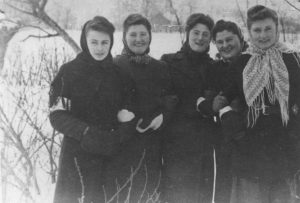
Klara with friends wearing white armbands in the Rohatyn ghetto. Source: Schnytzer-Wald Family Collection.
Klara does not describe living conditions in the ghetto in the first months of captivity, before starvation and disease began steadily killing the old and very young. She is shown in a photograph with four friends wearing the white armband as required to identify the women as Jews in what appears to be wintertime 1941~1942. Klara’s personal tale in the audio interview starts directly with the first major aktion (roundup and killing event) in Rohatyn, on 20 March 1942 during which her father Wolf and her youngest sister Anna were taken and shot to death with three thousand other Jews in the ghetto and at pits south of town which had been dug in advance to serve as a mass grave. Klara evaded the roundup with her mother Sara and middle sister Hela by hiding high in their house.
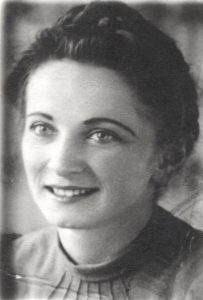
Klara’s sister Anna, who was murdered in the first aktion in Rohatyn. Source: Schnytzer-Wald Family Collection.
Meyer, Klara, her mother, and her sister Hela all survived the next two aktions in September and December 1942, in which more than 2000 Jews were deported to and gassed at the Bełżec extermination camp and several hundred more were shot to death in Rohatyn. The Walds had worked to prepare “bunker” hiding places in the ghetto in which to hide. Separate from his duties as ghetto police chief, Meyer not only helped Jews in the ghetto to arrange bunkers there but also worked to organize them to work together to resist future aktions. Meanwhile many Jews were dying each day in the ghetto, from starvation and especially from typhus due to the cramped quarters and the lack of medicines.
Sometime after the September 1942 aktion, a young Jewish woman named Rozka Faust was caught outside the ghetto trying to bring meat from a Ukrainian benefactor in to her family. Meyer Weisbraun intervened with the authorities to minimize Rozka’s punishment and gain her freedom. In gratitude for Meyer having also shielded Rozka’s benefactor from investigation, Rozka was asked to bring Klara to meet her. The woman was Anna Bachynska, wife of Lieutenant Bachynskyi – the head of the Rohatyn branch of the Ukrainian Auxiliary Police, charged with securing the ghetto perimeter and supporting regional German military and police in their suppression of Jews. Anna had been a music student of Rozka’s father David in the interwar period, and she gave work to David teaching her sons music and to Rozka teaching German to her daughters and making dresses during the German occupation. It was a very perplexing connection, which would preserve the lives of both Rozka and Klara.
By early 1943, Weisbraun believed he would die defending Jews in the ghetto or in the forests if another major aktion came, and he wanted to help his wife escape to Warsaw to work and live in disguise as an Aryan. Klara had already spent some time in Stryj (today Stryi) with a woman who did not realize she was Jewish; she had physical features, speech, and mannerisms which could easily pass for Ukrainian. As Klara says in her audio interview, the object now was to buy a forged kennkarte to provide false identity as cover for her. Paul Trepman, a Polish Jew working undercover in Rohatyn and Lwów (today Lviv) as an ethnic Pole running guns for the Polish “People’s Army” (Armia Ludowa, AL) resistance effort, agreed to take Klara to Warsaw and the two journeyed by sled and train over two days in mid-February, via Przemyślany (today Peremyshliany) and Lwów. Although Trepman’s version of the trip differs from Klara’s in some ways, the experience overall and the result are the same: Paul and Klara were identified as Jews by corrupt Polish police, blackmailed by those police and their associates, and denied the kennkarte; sensing immediate mortal danger, they returned to Rohatyn without success and worse for the effort.
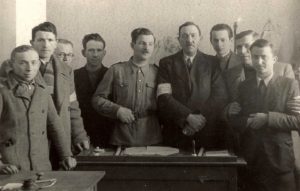
Rohatyn Judenrat members with armbands in autumn 1941. Jewish police chief Meyer Weisbraun is at center left. Source: Schnytzer-Wald Family Collection.
According to Trepman, Jews in the Rohatyn ghetto who had survived three aktions then heard through informal reports of the Warsaw ghetto uprising which began in April of 1943, and anticipated a final aktion in Rohatyn to liquidate the ghetto and the diminished Jewish community. Weisbraun had already organized a clandestine Jewish guerrilla unit, gathered a small number of arms, and made plans to construct a large defensive bunker for 300 people in a forest about 20km from Rohatyn. Tools and materials were carried nightly to the site and young Jewish men worked daily for three weeks to construct and disguise the bunker. Unfortunately the bunker was discovered by a forester before it could be put into service, but the number of Jewish resistance volunteers only increased, and Weisbraun traded what few precious items still remained in the ghetto for guns and ammunition; Trepman acted as a go-between for Weisbraun and the Ukrainians who supplied the weapons from captured Soviet and Polish stocks. Jewish families who still had means attempted to place their women and children with Ukrainian families in and around Rohatyn in anticipation of a major aktion any day or night. Rozka Faust and Klara began spending nights in hiding at the Bachynskyi house, sharing a room with Bachynska daughters Lida and Tanya.
In the early morning of 06 June 1943, when the Rohatyn ghetto liquidation began, Klara was at the Bachynskyi house while Lieutenant Bachynskyi was supporting the Gestapo from Lwów and the German Security Police from Tarnopol (today Ternopil) in rounding up the remaining Jews for execution. Meyer Weisbraun and the rest of the Jewish police were the first to be killed, as a threat against resistance by the rest of the Jewish community; Klara would not learn about his death until after the Soviet army drove the Germans out a year later. Klara remained with Rozka Faust, sheltered and fed by the Bachynskyi family (though she never saw the Lieutenant) for the next ten months. Klara’s sister Hela and their mother Sara also survived the ghetto liquidation; how and where is not clear.
The advancing Soviet army reached Tarnopol in April 1944 and made life in Rohatyn too risky for Ukrainians who had worked with the Germans or who had opposed the Soviet occupation earlier. The Bachynskis prepared to leave for Germany, and Rozka Faust left to search for shelter among the empty and shattered houses in the ghetto. Klara had heard that Hela was in a village on the Hnyla Lypa River about 5km from Rohatyn (perhaps Zalipie where their father had been born); Klara was taken by Anna Bachynska to a village not far from Rohatyn and then the next day joined her sister. Around this time, their mother Sara was murdered, but Klara did not learn of her death until after the German retreat.
Hela, whose husband Szymek Nagelberg had been killed earlier, was being sheltered and fed by a local Ukrainian man in a wheat field when Klara joined her; soon he dug a pit for them near the bank of the river, where they stayed together for four months. The pit was very cramped for the two sisters, too small to stand in or move around, but they stayed in it at all times; the man arranged a cover and brought food to them, and they arranged grass at a small window to disguise the opening. Before the Germans retreated they sometimes used the area for training maneuvers, once narrowly missing the pit in crossing, and Ukrainians occasionally searched the area, but the sisters were not discovered.
After the Soviet army entered Rohatyn and the district, one night the Ukrainian man brought Klara to a field in the direction of Rohatyn, and told her to wait while he investigated the situation in the town; Klara had difficulty walking because her ankles had become injured from contortion in the riverside pit. He met with a small number of Jews who had come out of hiding in Rohatyn or from the nearby forests. Among them, Israel Schnytzer told the man to bring any Jews he knew to Rohatyn, so the Ukrainian returned and brought Klara to Rohatyn. Hela stayed behind with the man, intending to return a week or two later, but Klara heard later that both of them were murdered by Ukrainian nationalists.
Now Klara had no family, and few friends. According to Rozka Faust, Israel Schnytzer, who had miraculously survived the shootings of the first aktion at the pits south of Rohatyn but lost his own wife and child in the event, and then endured the duration of the German occupation in fields and forests through strength and cunning, was “smitten with Klara”. According to postwar records from his own telling, Israel was born in 1912 in Rohatyn to Klara (née Dorfman) and Abraham Schnytzer, and Israel listed his prewar occupation as farmer, which may have also included trade; little else is known of the Schnytzer family before the war. In mid-1944, Israel followed the Soviet army back to Rohatyn and tried to recover his belongings, with limited success. Klara and Israel had known each other in the ghetto, until just before the liquidation, but had not seen or heard anything of each other for more than a year. With pressure from Soviet authorities for prewar Polish Jews to move west out of what would become Ukrainian SSR territory, and as Klara observes in the interview, with nothing to keep them in Rohatyn, after a few weeks of recovery Klara and Israel left together on foot with the Soviet army for Poland, stopping in Katowice where they married and attempted to restart their lives. Israel did some small business work for income, but he and Klara were not comfortable in Poland.
The Schnytzer couple’s experiences as displaced persons (DPs) were typical of many Jewish survivors who were homeless, without means, and faced with a myriad of relief organizations which struggled to coordinate with each other and with fractured governments, and to accommodate the great variety of survivors’ needs; it would be seven years before they would finally make a permanent home. Klara registered with the Rescue Committee of the Jewish Agency, but she and Israel left Poland in 1945, going with Soviet trucks to Budapest, where they remained for a year. Then they moved to the American-occupied zone in southern Germany, where many of the displaced were housed and processed for emigration to other countries, and where Jewish Holocaust survivors had access to the administrative services of the American Jewish Joint Distribution Committee (JDC, or “the Joint”) as well as the United Nations Relief and Rehabilitation Administration (UNRRA). Offered a place in a refugee camp, they chose to live privately in the city of Regensburg instead.
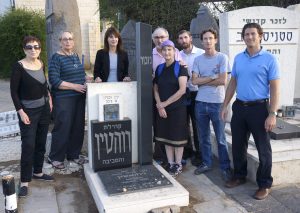
Klara’s son, his wife, and some of their children (at right) with other descendants of Rohatyn Jewish families at the symbolic grave for the lost Jewish community of Rohatyn at Kiryat Shaul Cemetery in northern Tel Aviv. Photo © RJH.
Israel and Klara registered with the DP services and were medically examined in Regensburg in September 1946, and they remained in the city for four years, where their only child, a son, was born in late 1947; Israel worked in business again. They received some support from the aid agencies, especially to help with the baby, but Israel disliked taking charity so they mostly lived off of their own income; Klara worked as a dressmaker. Still looking for a permanent home, on their DP registration cards they listed their desired destination as the United States. In the spring of 1947 they applied to the JDC help with for emigration to Argentina, but were not successful and closed the application two years later. The family moved to West Berlin, and ran two businesses in the Grunewald district there. However, as their son grew and approached school age, they decided not to raise him in Germany. A Jewish couple they had met years before in Lublin had moved with them to Budapest and then emigrated to Australia, but remained in contact with the Schnytzers; this couple helped Israel and Klara arrange the necessary papers to emigrate. The JDC funded their journey, and the Schnytzer family left Europe in November 1951 for Melbourne, Australia.
Klara and Israel at last established a new and peaceful home in Australia, where they would work and spend the remaining decades of their lives; Klara continued to suffer some from pain in her ankles, and both Klara and Israel from memories of the bitter past. Their son studied and became a renowned professor of economics, married and started his own family, embracing Judaism and moving to Israel to raise his family and continue his work. Israel died in 1979, the year before Klara’s interview (per Victoria vital records). Klara passed some time later, her memory cherished by her son and his family.
For the Central Database of Shoah Victims’ Names at Yad Vashem, pages of testimony were left in 1956 by Eugenia Wald, a first cousin to Klara, for the many Wald family members who died, and by Sabina Wind Fuks (who also left testimony for Meyer Weisbraun) in 1957.
Elements of the Interview with Value to Rohatyn Studies
Any recorded and published personal remembrance of the Holocaust in written, oral, or video format has value through time, both by itself in its original presentation and as a component of further historical analysis. Dozens of written recollections of prewar and wartime Rohatyn have been collected in the Rohatyn Yizkor Book (from 1962 and 2019) and in a small number of book-length memoirs, one dating from 1978 but mostly from 2000 forward. A number of video recordings of Jewish survivors of the Rohatyn ghetto (some of whom also left written testimonies) were made in the mid-1990s. The audio recording of Klara Schnytzer from 1980 presented here stands out among these records for several reasons.
Klara speaks with presence and clarity, unrehearsed but sharp in her recollections and audibly composed despite the horrors and personal tragedies she relates. She projects a recognition that she represents a community of survivors with both unique and shared experiences, and that speaking directly about the past is an important responsibility for her. She does not shrink from discussing the ethnic conflict which fueled the Holocaust and which lingered in central Europe after the defeat of Nazi Germany. Even though Klara was in contact after the war with some other Jews who survived the killing in Rohatyn, her own experiences, recollections, and attitudes are not blended with theirs in the telling of her story. Ultimately what one hears in Klara’s voice is the practicality and strength which helped her get through, alive and sane, one of the worst periods in human history.
Many voices of Rohatyn Holocaust survivors have still never been heard, and perhaps never will be. Among those is Israel Schnytzer, who told of his own prewar and wartime life to his wife, his son, and his grandchildren, but he did not leave a written or spoken record in his own words for others. We have glimpses in Klara’s audio interview, but beyond that we must rely on the Schnytzer family to keep Israel’s experiences alive.
We are grateful to the Melbourne Holocaust Museum and to the Schnytzer family for making Klara’s audio interview available now, more than 40 years after it was recorded.
Additional References
Much of the information presented here is summarized directly from the recorded interview. Important additional historical information was kindly provided by the Schnytzer family, who also provided access to photographs, reviewed this page and the interview transcripts, and liaised with the Melbourne Holocaust Museum to secure permission to use the original interview recording here.
Further references include:
- The Shoah in Rohatyn, a historical timeline on this website.
- Rosette Faust Halpern; A Journey Through Grief – The Autobiography of a Holocaust Survivor; lulu.com; 2013.
- Paul Trepman; Among Men and Beasts; translated from the Yiddish by Shoshana Perla and Gertrude Hirschler; A. S. Barnes and Co., Inc.; Cranbury, New Jersey, 1978.
- Donia Gold Shwarzstein; Remembering Rohatyn and Its Environs; Meyer Shwarzstein, publisher; 2019. See also the Yizkor Book for Rohatyn: The Community of Rohatyn and Environs (Kehilat Rohatyn v’hasviva); eds. M. Amitai, David Stockfish, and Shmuel Bari; Rohatyn Association of Israel, 1962 (in Hebrew).
- Rohatyn’s Wartime Righteous Gentiles, on this website
- Melbourne Holocaust Museum – Archival Collections
- Melbourne Holocaust Museum – Survival Testimonies
This page is part of a series on memoirs of Jewish life in Rohatyn, a component of our history of the Jewish community of Rohatyn.

